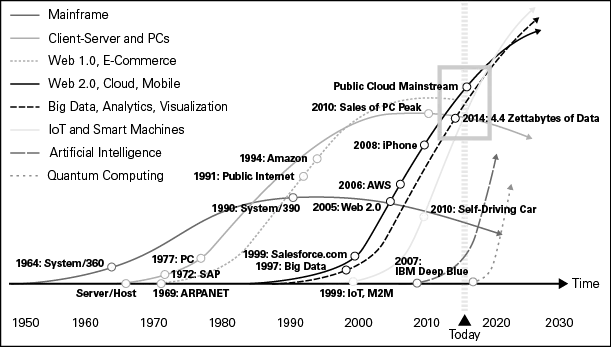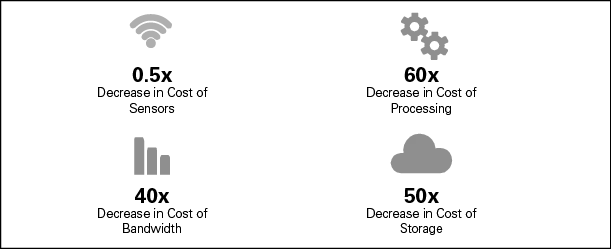![]()
PART I
The Industrial Internet of Things – Transforming Manufacturing Beyond Recognition
![]()
01
Industry’s Ongoing and Accelerating Digital Transformation
Smartened-up and tightly connected industrial manufacturing processes are going to go mainstream in just a few years in all advanced markets and many emerging ones. A sub-segment of the Internet of Things, the Industrial Internet of Things (IIoT), will digitally orchestrate factory floors, physical products, workers and more, unleashing enormous value. However, critical to the success of this new world will be deployment of the right technology, orchestration of it in the right way, the embedding of enterprises in the right ecosystems of business partners, and last but not least, finding adequately skilled people.
As is already fairly common knowledge, the Internet of Things (IoT) put very simply refers to appliances networked via digitization. Most readers will have at least a nodding acquaintance with some common examples, whether by reputation or direct experience: cars, toasters, fridges and central heating systems that can be monitored and controlled from household computers and smartphones.
The Industrial Internet of Things is a key subset within the IoT, less visible than our common household objects, but with arguably far greater power to revolutionize the way the world works. It creates, via connected technologies and various platforms, highly efficient relationships between products, machines, services, and sites, but also between customers, workers, managers, suppliers and partners.
It is, in short, the main bridge between the physical and digital enterprise applications enabled by the so called “fourth industrial revolution” – that is, the revolution in industry brought about by digital technology. This is really many revolutions in one, comprising various advances such as artificial intelligence, robots, big data analytics and, in the pipeline, quantum computing.
FIGURE 1.1 – Combinatorial Effect of Technology1
The combinatorial effect of all these (Figure 1.1) is unprecedentedly seismic, probably the single most dramatic cataclysm in consumer and business goods manufacturing in human history, overhauling practically every business conviction generally held dear, whether in resource allocation, production process sequencing, materials handling, workforce involvement, customer relationship or environmental management.
In a way, it is tempting to see the IIoT as actually synonymous with the fourth industrial revolution because it does so much to unify all the innovations by networking them. However, as the other examples I’ve given indicate, it is by no means the whole revolution on its own. The IIoT is, if you like, what turbocharges the combinatorial effect of these already wildly disruptive technologies by seeing them work in concert.
This book is not a comprehensive guide to the entire fourth industrial revolution – to every node of technological change that comprises it. Its focus is very much the IIoT. However, precisely because the IIoT connects the other factors, it offers a key route into understanding how to capitalize upon the whole and avoid being left behind.
In particular, I will look at the innovations in connectivity and data collection that enable the IIoT alone: tech such as sensors, portable devices, the cloud, application programme interfaces (APIs) and apps. These are exploding.
All this is set to shake up research and development, manufacturing, aftersales, and product and service configurations. In numerous industrial settings, the drift, albeit often tentative, has already begun towards digitally run shop floors, management processes, platforms and ecosystems.
This opens up space to establish new income streams for enterprises and allows companies to set a strategic course for entirely new business models focused on delivering quality “outcomes” for customers rather than just physical products.
Outcomes are another reason why the emergence of the IIoT is an event of such historical significance. It marks the end of roughly 200 years of modern industrial production habits because it relegates basic products to insignificance compared to the results they deliver at any given moment thanks to their digital connectivity.
We are right at the tipping point of this change and there is simply no better time to be getting to grips with it. The entire purpose of this book is to help you do this. In this chapter I will further delineate the significance of the IIoT, giving a sense of the (relatively early) stage of development it is at now.
Finally, as a sort of summary overview of the other chapters in this book, I will sketch out some key steps you need to take and concepts you need to understand to correctly position your company in the IIoT’s radically new landscape.
The Drivers of Change in the Industrial Sphere
The connected, smart product is at the core of the change. The combination of smart products, services and new experiences will disrupt legacy business models and shake up the entire product value chain.
Before we go any further, let’s lay out the key drivers leading the move towards the IIoT (Figure 1.2).
Figure 1.2 – The Drivers for Change in the Industrial Landscape2
1. Pervasiveness of connected technology creates context. As shown in Figure 1.2, sensors, connectivity, APIs and data in products at commodity price levels will drive new levels of intelligence in smart products.
2. Platforms and data for optimization. Smart products, pushed to become Living Products by sophisticated embedded software, will be connected to platforms during operations and accompanied with analytics and data-driven services to optimize their operation.
3. Ecosystems and services drive value. Data and services provided by smart products and platform ecosystem allow creation of mutually complementing value-add services and new revenue streams while the smart product is in operation.
4. Hyperpersonalization and new experiences disrupt. Smart products have the ability to hyperpersonalize, adapting to the individual product user in his or her individual context with the objective of optimizing the business outcome. Hyperpersonalization creates new experiences for the individual. This leads to a new level of competition around the combination of smart products, services and new experiences, potentially disruptive to existing business models.
5. As-a-service business models emerge. Consumption-based business models replace traditional “sell-and-maintain” business models. This involves significant changes to the balance sheet with capex shifting from customer to the as-a-service provider.
6. New technologies will disrupt further. Robotics, autonomous systems, artificial intelligence and deep learning, augmented and virtual reality, 5G networks, 3/4D Printing, blockchain, and other new technologies will reach industrial strength and radically impact the way products are engineered, manufactured and operated.
7. Security and data privacy ensure resilience and fairness. Progress in industrial-strength security, data ownership and sharing, and data privacy solutions are a prerequisite for the IIoT. Security solutions will be engineered to provide resilience during cyber attacks and new principles around data sharing will ensure fairness between stakeholders.
Technology Becomes Affordable and Puts Speed Behind the IIoT
Why is the current moment in the development of the IIoT so crucial? Because of the standard pattern by which innovations often reach maturity and marketability: IIoT technology has simultaneously become cheaper and its sophistication has increased, making it ready to go mainstream.
Production costs and market prices have tumbled to commodity levels over the last two decades or so for many technologies critical to the IIoT: cloud computing services, processing power, storage space, analytics tools, mobile connectivity, and components such as sensors. Prices have fallen by up to a factor of 50 compared to only a few years ago (see Figure 1.3). Concurrently, new waves of innovation have succeeded their predecessors with exceptional and increasing speed, shortening the window within which to absorb and adapt to the changes.
Figure 1.3 – A Decade of Eroding Cost Fuels the Rise of the Internet of Things3
All this greatly increases both the feasibility and attractiveness of new investment cases unthinkable only a few years ago. A small ironmonger operating an assembly line in an urban backyard, for instance, can now buy software-controlled sensor kits to apply a basic form of predictive analytics for lathe maintenance or managing energy consumption.
Such small-scale entrepreneurs will probably soon be using process engineering equipment that, not long ago, existed only in research laboratories or would have cost a fortune to integrate into ordinary factory floors.
The potential for rendering old-style enterprise arrangements smart from end-to-end, then, is huge. Research anticipates that around two thirds of today’s companies can easily boost efficiency and value via a gradual introduction of digitized processes, as many of their departments have barely been put on a digital footing at all over the last decades. This will soon streamline and optimize businesses around the world and pump trillions of dollars of income into ...



